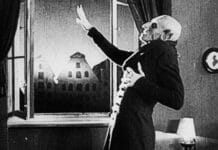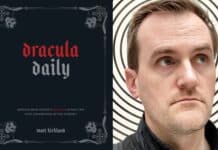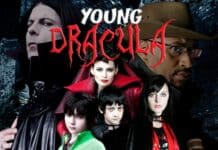BARRY McCANN reviews the Jess Franco-directed El Conde Dracula (1970) – the one with Christopher Lee as Dracula in a moustache!
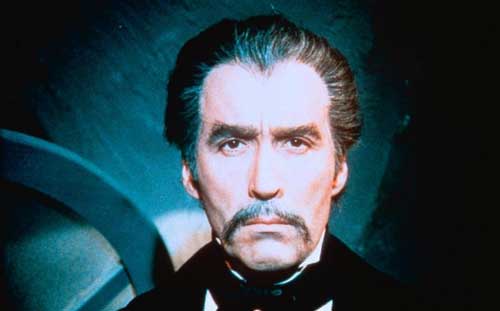
TITLE: El Conde Dracula aka Count Dracula
YEAR RELEASED: 1970
DIRECTOR: Jess Franco
CAST: Christopher Lee, Herbert Lom, Klaus Kinski, Susann Korda
Over fifty years ago, Bram Stoker wrote the greatest of all horror stories. Now, for the first time, we retell exactly as he wrote, one of the first — and still the best — tales of the macabre.
Thus spoke the opening title of what was the third English language adaptation of Bram Stoker’s original classic. A production that promised to give reigning Dracula, Christopher Lee, a chance to break away from the hissing predator of the Hammer films and reconnect with the character of the novel. A film that starts off with the best of intentions, but does it live up to them?
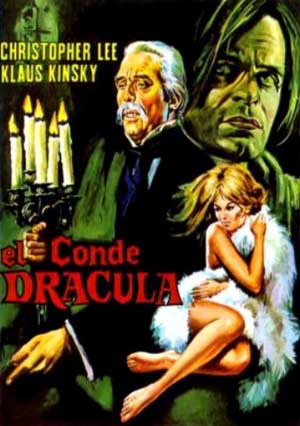
It opens with Jonathan Harker journeying to the Borgo Pass to be picked up by a mysterious coachman, who takes him to castle Dracula. There, he is greeted by a gaunt old man who introduces himself as the Count, one who apparently casts no reflection.
Harker goes to sleep in his chamber, but wakes up in an ancient crypt and is seduced by a trio of female vampires. Dracula bursts in and orders the women off, giving them a baby to feed on, while its mother screams outside the castle. Harker wakes up in his room and discovers two small wounds on his neck. After finding the crypt where Dracula and his brides are sleeping in coffins, he runs out and jumps into the river below.
Awakening in a London psychiatric clinic, Harker is a patient of Dr. Seward, having been found delirious in a river near Budapest. No one believes his account of events at Castle Dracula until Van Helsing finds the two punctures on his neck. Harker’s fiancée Mina and her friend Lucy arrive at the hospital to take care of him. Meanwhile, Dracula is hiding in a nearby abandoned abbey and also has control over Renfield, an inmate in the asylum.
As Mina nurses Harker back to health, Lucy’s health declines. Dracula has been secretly visiting her by night and drinking her blood, growing younger each time. An attempt to save her with a blood transfusion fails and she dies. Now undead, Lucy murders a young child, before being staked Quincey Morris, Seward and Van Helsing.
The Count begins vamping Mina, while Van Helsing suffers a stroke and is confined to a wheelchair. Dracula visits the weakened man and mocks his attempts to destroy him. Quincey, Harker and Seward track Dracula to the abbey, where they are menaced by reanimated stuffed animals, while the Count flees back to Transylvania. Harker and Quincey pursue and battle Gypsies before setting fire to Dracula’s coffin, consuming him with flames.
Producer Harry Allen Towers had planned a definitive adaptation of Stoker’s story, utilising the best talent in the horror business. Christopher Lee accepted a chance to play the Count of the novel, while Vincent Price was cited for Van Helsing and Mario Bava possibly to direct. However, even the combined Italian, Spanish and German budget could not live up to aspiration and production was scaled down.
The film starts off well with the Transylvanian scenes adhered to closely, complete with the Count’s lizard crawl down the castle wall and the wolf attack on the grieving mother, while Lee plays the Count as a white haired old man who grows younger as the story progresses. However, once the action shifts to London, the skimping begins. Arthur Holmwood is airbrushed out and Quincey becomes Lucy’s fiancée.
Klaus Kinski’s Renfield is never seen so interact with his master, but rants, raves and eventually jumps to his death. Van Helsing is mysteriously written out of the finale, because the budget could only afford so much of Herbert Lom‘s time. In fact, Lom shot his scenes separately from Christopher Lee, a meeting between them being constructed by stitching separately filmed shots of their characters apparently confronting each other.
Much blame has been put on director, Jess Franco, famous for his lurid low budget horror flicks such as The Awful Dr. Orloff (1961), and fresh from putting the cramps into Harry Allen Towers’ final two Fu Manchu movies with his usual zoom shots, pastel colours and grainier photography. However, he did restrain his perchance for gore, rendering El Conde Dracula a more old fashioned film than its Hammer contemporaries.
Unfortunately, Franco’s hasty approach to directing – dictated by limited time and budget – results in some gaffes. The ride to Castle Dracula is undermined by the reflection of camera lights on the coach, while the shadow of the camera is also visible in Renfield’s padded cell. Having German Shepherds stand in as wolves is as unconvincing as the scene where our heroes are menaced by animated stuffed animals, which Franco realised by having members of the crew nudge the beasties off screen like a something from the 1970s TV comedy, The Goodies.
The financial constraints also meant that the film had to shot on location in Franco’s native Spain, with some filming in West Germany. This adapted well enough for the Transylvania scenes, but given the obvious Spanish architecture of the London section, Franco might as well have set it in Madrid. At least that would have fitted.
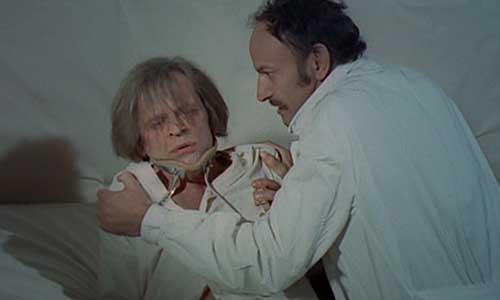
These weaknesses aside, El Conde Dracula still remains a curiously engaging film. The Transylvania section is closer to the novel than before, and Franco does manage to get an extra something out of some later scenes, such as the sensually evocative moment when Dracula summons Lucy from her room to meet him under the dark archways.
The cast also turn in some decent performances. Lee is a subdued, thoughtful Dracula with a more central role than in the Hammer films, while Klaus Kinski invests his Renfield with an interestingly restrained madness. Unfortunately, Herbert Lom has not enough screen time to prove his Van Helsing, and his sudden exit from the narrative is an obvious short cut.
El Conde Dracula has a place in any aficionado’s collection, if only to how Christopher Lee might have perfected the part if given a proper chance. Not the faithful adaptation promised, but not a complete failure either. Something of a curate’s egg.
Tell us your thoughts on El Conde Dracula 1970 in the comments below!


